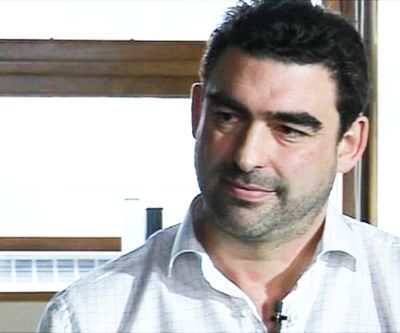Update 28 September: Winners announced here.
Update 20 September: Finalists announced here.
Update 19 September: Semifinalists announced here.
Update 15 September: Voting round now open, will close on 18 September 11:59 pm EST. Go here to browse the nominated posts and vote.
* * *
We are very honored and pleased to announce that Nick Lane has agreed to be the final judge for our 6th annual prize for the best blog and online-only writing in the category of science. Details of the previous five science (and other) prizes can be seen on our prize page.
 Nick Lane is a British biochemist and writer. He was awarded the first Provost's Venture Research Prize in the Department of Genetics, Evolution and Environment at University College London, where he is now a Reader in Evolutionary Biochemistry. Dr Lane's research deals with evolutionary biochemistry and bioenergetics, focusing on the origin of life and the evolution of complex cells. Dr Lane was a founding member of the UCL Consortium for Mitochondrial Research, and is leading the UCL Research Frontiers Origins of Life programme. He was awarded the 2011 BMC Research Award for Genetics, Genomics, Bioinformatics and Evolution, and the 2015 Biochemical Society Award for his sustained and diverse contribution to the molecular life sciences and the public understanding of science.
Nick Lane is a British biochemist and writer. He was awarded the first Provost's Venture Research Prize in the Department of Genetics, Evolution and Environment at University College London, where he is now a Reader in Evolutionary Biochemistry. Dr Lane's research deals with evolutionary biochemistry and bioenergetics, focusing on the origin of life and the evolution of complex cells. Dr Lane was a founding member of the UCL Consortium for Mitochondrial Research, and is leading the UCL Research Frontiers Origins of Life programme. He was awarded the 2011 BMC Research Award for Genetics, Genomics, Bioinformatics and Evolution, and the 2015 Biochemical Society Award for his sustained and diverse contribution to the molecular life sciences and the public understanding of science.
Nick Lane is the author of four acclaimed books on evolutionary biochemistry, which have sold more than 100,000 copies worldwide, and have been translated into 20 languages.
Nick's first book, Oxygen: The Molecule that Made the World, is a sweeping history of the relationship between life and our planet, and the paradoxical ways in which adaptations to oxygen play out in our own lives and deaths. His next book, Power, Sex, Suicide: Mitochondria and the Meaning of Life, is an exploration of the extraordinary effects that mitochondria have had on the evolution of complex life. Nick's third book, Life Ascending: The Ten Great Inventions of Evolution, is a celebration of the inventiveness of life, and of our own ability to read the deep past to reconstruct the history of life on earth. The great inventions are: the origin of life, DNA, photosynthesis, the complex cell, sex, movement, sight, hot blood, consciousness and death. Life Ascending won the 2010 Royal Society Prize for Science Books, and was named a Book of the Year by New Scientist, Nature, the Times and the Independent, the latter describing him as “one of the most exciting science writers of our time.” Nick's most recent book, published in 2015 is entitled The Vital Question: Why is Life the Way it Is? It attacks a central problem in biology – why did complex life arise only once in four billion years, and why does all complex life share so many peculiar properties, from sex and speciation to senescence? The book argues that energy has constrained the whole trajectory of evolution, from the origin of life itself, to the properties of complex organisms including ourselves.
As usual, this is the way it will work: the nominating period is now open. There will then be a round of voting by our readers which will narrow down the entries to the top twenty semi-finalists. After this, we will take these top twenty voted-for nominees, and the editors of 3 Quarks Daily will select six finalists from these, plus they may also add up to three wildcard entries of their own choosing. The three winners will be chosen from these by Dr. Lane.
The first place award, called the “Top Quark,” will include a cash prize of 500 dollars; the second place prize, the “Strange Quark,” will include a cash prize of 200 dollars; and the third place winner will get the honor of winning the “Charm Quark,” along with a 100 dollar prize.
(Welcome to those coming here for the first time. Learn more about who we are and what we do here, and do check out the full site here. Bookmark us and come back regularly, or sign up for the RSS Feed.)
The schedule and rules:
September 7, 2015:
- The nominations are opened. Please nominate your favorite blog entry by placing the URL for the blog post (the permalink) in the comments section of this post. You may also add a brief comment describing the entry and saying why you think it should win. Do NOT nominate a whole blog, just one individual blog post.
- Blog posts longer than 4,000 words are strongly discouraged, but we might make an exception if there is something truly extraordinary.
- Each person can only nominate one blog post.
- Entries must be in English.
- The editors of 3QD reserve the right to reject entries that we feel are not appropriate.
- The blog entry may not be more than a year old. In other words, it must have been first published on or after September 7, 2014.
- You may also nominate your own entry from your own or a group blog (and we encourage you to).
- Guest columnists at 3 Quarks Daily are also eligible to be nominated, and may also nominate themselves if they wish.
- Nominations are limited to the first 100 entries.
- Prize money must be claimed within a month of the announcement of winners.
September 14, 2015
- The public voting will be opened.
September 18, 2015
- Public voting ends at 11:59 PM (NYC time). Semifinalists are announced.
September 19, 2015
- The finalists are announced.
September 28, 2015
- The winners are announced.
One Final and Important Request
If you have a blog or website, please help us spread the word about our prizes by linking to this post. Otherwise, post a link on your Facebook profile, Tweet it, or just email your friends and tell them about it! I really look forward to reading some very good material and think this should be a lot of fun for all of us.
Best of luck and thanks for your attention!


